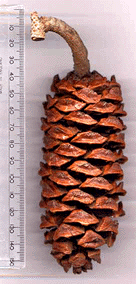
Link to photo in the Michael P. Frankis cone collection.
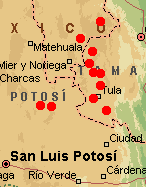
Range of Pinus nelsonii (Farjon and Styles 1997). Basemap from Expedia Maps.
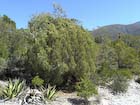
A tree 5 m tall [C.J. Earle, 2007.02.18].

Trees in habitat are noticeably yellow-green [C.J. Earle, 2007.02.18].

Yellow-green P. nelsonii against a stand of dark green P. cembroides [C.J. Earle, 2007.02.18].

Foliage [C.J. Earle, 2007.02.18].

Two fascicles, one opened to show the separate needles [C.J. Earle, 2007.02.18].
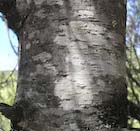
Bark on a 15 cm diameter tree [C.J. Earle, 2007.02.18].

Mature seed cone [C.J. Earle, 2007.02.18].
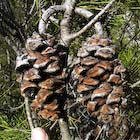
WP254, Two mature cones [C.J. Earle, 2007.02.18].
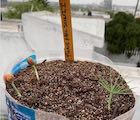
Recently germinated seedlings [Facebook post by Victor Hugo Garza Guajardo, 2020.03.15].

Comparison of Pinus cembroides (above) and P. nelsonii (below) twigs [C.J. Earle, 2007.02.18].

Conservation Status

Pinus nelsonii
Shaw 1904
Common names
Piñon de Nelson [Spanish], Nelson piñon (Lanner 1981).
Taxonomic notes
A highly distinct endemic with several unique features and no close relatives, it is only distantly related to the piñons with which it has usually been classified in the past. The comment in its first description, "[a] very curious species" (Shaw 1904) holds ever more true each time it is studied. It is more aberrant than any other species in the genus and is probably of ancient origin.
Description
A small tree reported to 10 m (Shaw 1909, Perry 1991, Farjon and Styles 1997), though rarely more than 6-7 m tall or 20 cm dbh (M.P. Frankis, field notes, 1991.11, and my observations in 2007.02). Bark smooth, dull grey on stems up to about 15 cm diameter, becoming dark and longitudinally fissured on larger stems. Crown rounded, dense, with upcurved branches erect for their top 2-3 m. Leaves a conspicuous yellow-green, in fascicles of 3(-4), but the individual leaves in each fascicle remaining tightly 'zipped' together by their serrulate margins (Bailey and Hawksworth 1988) and so appear single; they can be separated by rubbing the fascicle in the hand (see photo). Fascicles 4-7.5 cm long, about 1 mm thick; sheath fully persistent (unlike all other pines in subgenus Strobus). Seedlings have only juvenile foliage for several years. Cones cylindric, 6-12 cm long, 4-5 cm broad, green ripening to a rich bright red-brown, carried reflexed down the stem on stout downcurved peduncles 3-7 cm long and 7-10 mm thick. Scales finely wrinkled, short, stout, 20-25 mm broad, with a transverse ridge and a large but ill-defined 10-15 mm umbo. Seeds large, 10-12 mm, blackish with a red spot near apex, wing 1-2 mm, vestigial, usually remaining attached to the scale when seed removed. Seeds do not fall naturally from cone, but are dispersed by birds, mainly gray-breasted jay Aphelocoma ultramarina (Lanner 1981; M.P. Frankis, field notes, NE Mex., 1991.11); after seed dispersal the cones usually fall, leaving the peduncle on the branch. Cones mature in November about 18-19 months after pollination. The species is unique in Pinus in not showing a resting stage at 6-12 months (hence the ill-defined umbo); the six-month old conelets are already nearly half the mature size (Shaw 1909; M.P. Frankis, field notes, NE Mexico, 1991.11). The cones are also unique in Pinus in sometimes having leaf fascicles on the peduncle; these fascicles are normal but fall before the cone is mature (M.P. Frankis, field notes, NE Mex., 1991.11). See García Esteban et al. (2004) for a detailed characterization of the wood anatomy.
When trying to identify this tree out in the field, two characters really set it apart from the P. cembroides that grow with it. One is the foliage, which is a yellow-green that is highly distinct from the deep, rich green of the P. cembroides. The other prominent difference, which is visible on branches and stems up to at least 15 cm diameter, is that the stems of P. nelsonii are quite smooth, whereas P. cembroides has rough stems from the start, due to the decurrent pulvini, and become rougher over time.
Distribution and Ecology
NE Mexico, local (Lanner 1981) in Nuevo León, San Luis Potosí and Tamaulipas, at 1800-2500(-3200?) m elevation (Perry 1991). It usually grows mixed with P. cembroides and mixed xerophytic shrub vegetation including cacti and agaves in fairly flat, very dry areas (M.P. Frankis, field notes, NE Mexico, 1991.11). In both sites I have seen, it is growing on limestone. See also Thompson et al. (1999). Hardy to Zone 8 (cold hardiness limit between -12.1°C and -6.7°C) (Bannister and Neuner 2001).
Remarkable Specimens
Ethnobotany
The seeds are edible, and quite tasty; local indians prefer them to seeds of P. cembroides (Lanner 1981).
Observations
Perry (1991) gives instructions for reaching stands near Doctor Arroyo and Miquihuana; he states that guides and four-wheel drive vehicles or horses are essential. In my experience, I have seen it in two locations, both readily accessible with normal automobiles. The most easily accessible site is located along the road up Cerro Potosí in Nuevo León. From Monterey go to Galena, and then northwest on a good paved road to the village of Dieciocho del Marzo. From here, the dirt road up the peak is prominently signed. After passing the entrance station (where in 2007 I had to pay a 10-peso entrance fee), it is only another kilometer or two before P. nelsonii can be seen growing along the roadside, in a mixed stand with P. stormiae and P. cembroides. The trees are mostly less than 2 m tall, but some that I saw were bearing cones. This stand is located at 24.8860°N, 100.1889°W, elevation 2130 m. If you go here, do not fail to check out some other rare pines in the area, P. greggii and P. culminicola. The second place that I have seen P. nelsonii is harder to get to, but still not particularly difficult, and a good part of the approach road was being paved in February 2007. I approached it from Matehuala in San Luis Potosí. From here, find the road east out of town to Doctor Arroyo (poorly marked; a good road map and a GPS help) and from Doctor Arroyo follow the highway north about 15 km to a junction where you head east about 7 km. Then, a pretty good but unsigned gravel road heads northward into the Cerro Peña Nevada. At 23.78°N, 99.91°W, 1884 m elevation, the road enters the P. cembroides-J. flaccida forest. After gaining about 275 m elevation you reach the P. nelsonii at 23.8031°N, 99.9000°W, and the stand continues along the road for a couple of kilometers, where it gives way to a very interesting stand of P. stormiae. In the stand, the P. nelsonii are growing with P. cembroides, J. flaccida, and various angiosperm shrubs. There is ample regeneration of both pines. These trees are growing on limestone, or more precisely, a recemented colluvial deposit comprised of limestone clasts cemented by caliche. The big, mature P. nelsonii are of about the same stature as their P. cembroides counterparts, which is about 8 m tall. The norm is about 4 m tall. There's a very small village - a few houses, no stores - not more than 200 m from here, and I expect they come here for firewood, and maybe an occasional fencepost.
Remarks
Although P. nelsonii is still locally abundant in its natural habitat, its range is restricted and it is vulnerable to fire damage in closed-canopy stands. Very few specimens are currently known in cultivation.
Citations
Shaw, G.R. 1904. Gardener's Chronicle ser.3, 36: 122, f.49.
This page edited with M.P. Frankis, 1999.01.
See also
The species account at Threatened Conifers of the World.











